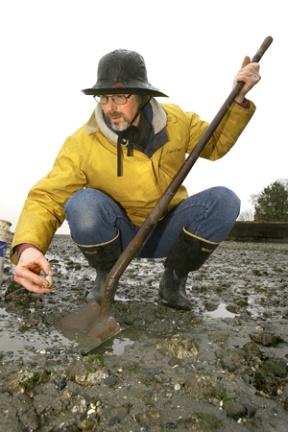Polluted shorelines have legislators and diggers calling for cleanup, restoration.
The slogan from Puget Sound’s most famous clam chowder pitchman still rings in Gary Quitslund’s ears.
“Old Ivar Haglund used to say, ‘when the tide’s out, the table’s set,’” the island native said, before digging into a Rolling Bay beach Friday morning. “I’ve been digging all my life, pretty much. I grew up on the beach and dug clams with my parents, so it’s kind of like a tie to my past. But I also dig ‘em because I love to eat ‘em.”
Quitslund sets his table with fried geoduck fritters, steamed Manila clams with butter and lemon, or throws some Pacific littlenecks in a pot for a slow-cooked tomato sauce.
But at least one seaside staple has been permanently removed from his menu.
“I used to dig butter clams, which are everywhere,” he said. “Now they’re nothing to fool around with. They can kill you.”
Last summer, shellfish from the island’s northeast shore were ranked the fourth most toxic in the state. Almost 4,800 micrograms of “paralytic shellfish poison” were found in 100 gram butter clam samples taken from Skiff Point, according to the state Department of Health.
A lethal dose of PSP, or “red tide,” as it is commonly known, is just 3,000 to 3,500 micrograms. The state’s harvest closure threshold is 80 micrograms.
PSP does not adversely affect shellfish, but can cause severe nervous system damage, paralysis and death in the animals and humans that eat them.
Recognizing the health risks and environmental implications of contaminated shellfish, Rep. Sherry Appleton has proposed legislation to boost protections in areas where shellfish are most impacted.
Her district, which includes Bainbridge Island and North Kitsap, is lined with many of the sound’s most contaminated shellfish.
“We need to do something bold,” Appleton said in recent testimony to the state House committee on Puget Sound. “I hear people always say, ‘Washington state? I love your oysters and I love your clams.’ But I don’t think the population knows how critically Puget Sound is sick.”
Or how sick the sound will make the population. Mussels taken from Miller Bay, just north of the island near Suquamish, exhibited PSP levels three times the lethal dose. Brownsville and Agate Passage also made the state’s top 10 list, with 3,400 and 3,200 micrograms. Blakely Harbor’s 2,100 microgram samples also made a strong showing, ranking the south island cove 13th in the state.
The entire island remains closed to butter clam harvesting, while the health department warns that certain organs inside island geoducks may contain harmful amounts of PSP.
“The east side of Kitsap County was just god awful last summer,” said health department marine biotoxins coordinator Frank Cox. “We had a record number of (toxic) sites, but your area was the worst in Puget Sound. In my 29 years of looking at this, I’ve never seen things this toxic.”
Cox believes heavy winter rains flushed high levels of land-based nutrients – such as fertilizers and human waste – into the sound. This ready supply of food, combined with an unusually warm summer and calm waters, encouraged massive blooms of toxic plankton along the county’s east side, he said.
Appleton’s bill would upgrade existing rules governing ‘shellfish protection districts’ and add tougher requirements for implementing clean-up and prevention programs.
According to the Kitsap County Health District, such programs target failing septic systems and inadequate animal waste management.
Both of these ‘non-point’ sources of fecal coliform pollution spark plankton blooms that concentrate in filter-feeding shellfish, making them toxic to humans.
House Bill 1595 would also provide a funding boost – $1 million – to jump-start programs some conservationists say have come with plenty of lip service but little bite.
“This adds some teeth,” said Betsy Peabody, executive director of the Bainbridge-based Puget Sound Restoration Fund. “Protection districts were required to form but didn’t require implementation.
“That was a big issue because it brought people to the table but they were at a standstill.”
Peabody’s group worked on shellfish protection districts in Thurston and Whatcom counties, where studies identified land-based sources of the plankton blooms that cause PSPs, but little was done within the programs to correct problems.
“They could identify the problem, but because they couldn’t do anything, it became just a finger-pointing exercise,” Peabody said.
Appleton’s bill would also put more emphasis on preventing contamination before areas become rife with PSP, according to People for Puget Sound’s Bruce Wishart.
“Prevention is always cheaper than clean-up,” he said, adding that a third of all Puget Sound shellfish beds were closed in 2005.
Closures have had a crippling impact on harvesters, said Bill Dewey of Shelton-based Taylor Shellfish Farms.
“For a small company with one growing area, when that’s closed, they’re out of business,” he said during testimony in favor of Appleton’s bill. “This (bill) fixes a significant flaw (and) gives incentive to act when an area is threatened.”
Protecting the state’s shellfish industry and recreational harvest beds keeps local dinner tables – and the people gathered around them – linked to their environment, said Peabody.
“Pulling food out of the water gives us a direct connection to the place we live,” she said. “And, ultimately, it forces us to clean the pollution affecting it.”
****************************************************************
Dig carefully
The state Department of Health has closed all butter clam harvesting on Bainbridge Island due to high levels of paralytic shellfish poison, or ‘red tide.’ Symptoms of PSP exposure through eating shellfish include numbness of the lips and tongue, nausea, vomiting, muscle weakness and difficulty breathing. There is no antidote for PSP, and extreme exposure can be fatal. Toxic shellfish do not look or taste any different than safe shellfish. PSP cannot be destroyed through cooking. For more information, visit the state Department of Health’s website: www.doh.wa.gov or call the biotoxin hotline at (800) 562-5632.



